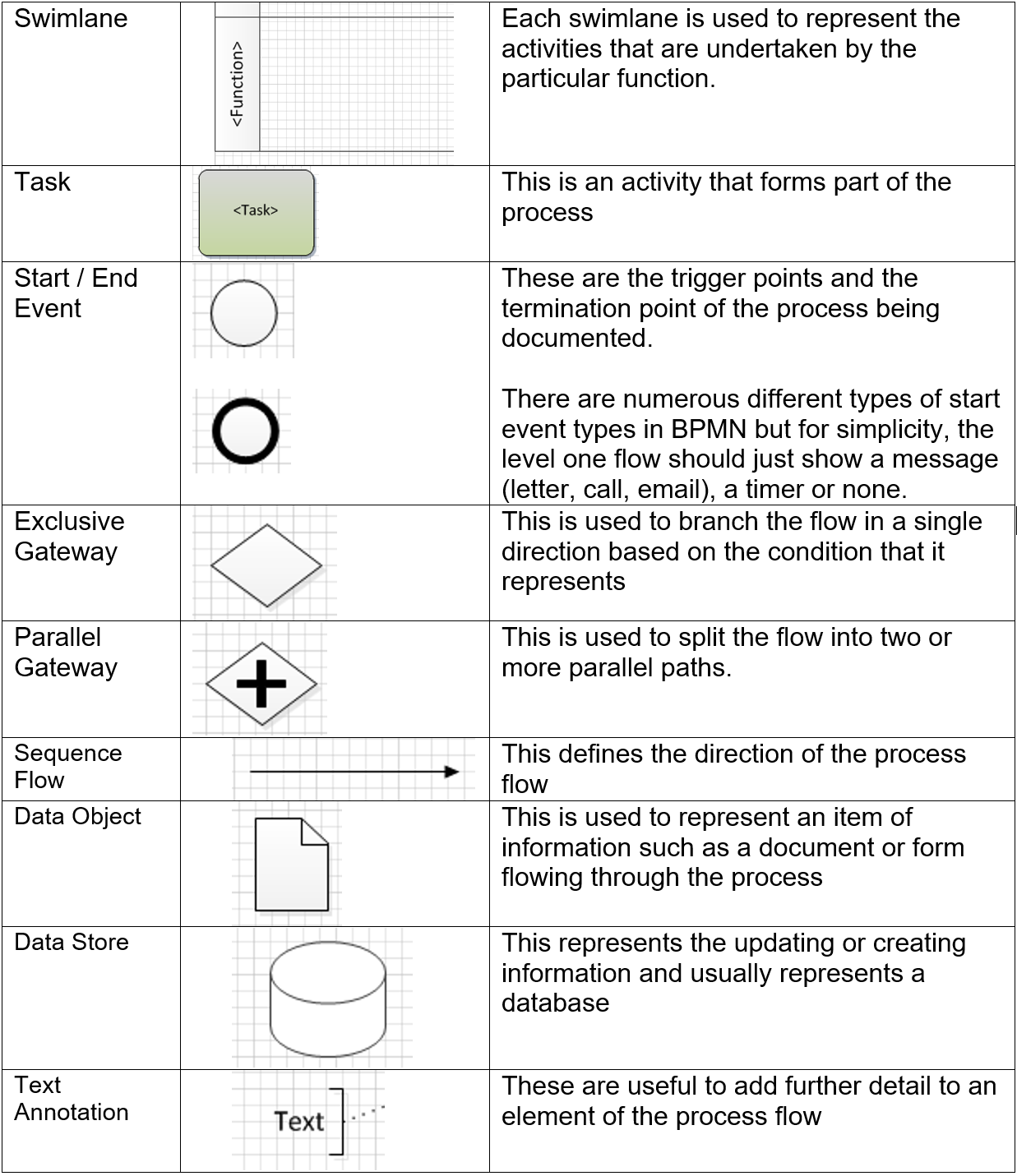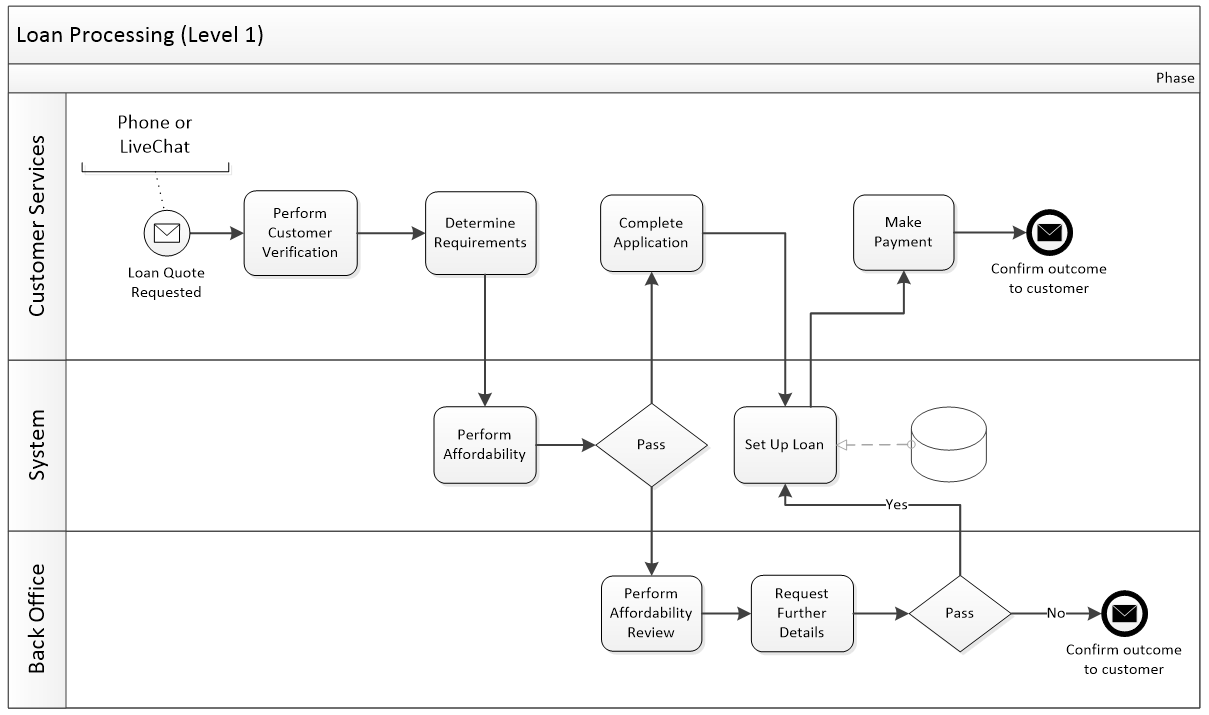
Introduction
The purpose of this article is to provide some introductory guidance on the concept of a multi-level approach to process mapping and where relevant include details on the type of notation that can be used to depict a process flow at different levels.
Often as a business analyst you are assigned to a project which involves changes to an existing process. One of the most useful starting points is to gain an understanding of the end to end process at a high level. At this stage you don’t need to be concerned too much about the detail of the process, you just need to identify the primary steps and who they are performed by.
Approach
I would normally adopt a multi-level approach to the exercise because it enables you to build up your knowledge of the business process in a logical approach that moves from the general to the particular. Without an understanding of the wider business context within which a process lays you can miss out on important detail or information.
Guidelines
As a starting point, the following guidelines are useful to bear in mind:
- Typically, a level one process will fit on a single side of A4 in landscape orientation
- Between 6-10 process steps will provide sufficient detail
- It should be easy to understand by anybody who looks at it. The notation should be familiar to anybody with a basic knowledge of flowcharting. You could include a key if the audience is completely unfamiliar with these diagrams.
Normally, the participants in a high level process modelling activity are managers or the process owners. You can generally identify these individuals by consulting the project RACI or through consultation with the project manager.
Due to the high level nature of the activity, it is normally possible to model the process in a workshop lasting about an hour. Typically, you should adopt the ‘brown paper and sticky note’ approach, whereby activities are written down on post it notes and stuck to the paper. You can use different coloured notes to represent different elements (such as questions/queries/volumes etc) or these can be captured on a flip chart.
Outputs
Along with capturing the process flow these sessions will also draw out a lot of valuable insight and perspectives as to what the process owners think is wrong with the process and where the current issues lie.
This information is very useful and it should be captured and validated in the next, more detailed iteration of the process mapping exercise. During the initial high level proves mapping session, it is worth bearing in mind the scope of the work that you are undertaking. It is easy for these sessions to drift into discussions of areas that may not be directly linked to the work that is being done. You can capture these points briefly but don’t get drawn into tangential discussions. Part of the BA skillset is workshop facilitation and you can draw on these skills to steer the conversation back to the agreed scope. Often, it is useful to have a flip chart sheet (sometimes called a ‘car park’) to record these details.
One of the really useful pieces of detail to identify during the discussion is the names and roles of other stakeholders who are involved with the lower level detail of the process. It is useful to capture these names to support the planning of the more detailed, level 2 process mapping. You can seek permission to speak to the other stakeholders as part of the subsequent workshops or at least highlight that their involvement may be required.
The objectives of the workshop should be communicated in advance to the participants along with the approach and the desired outcome. These should be re-capped at the start of the session.
Mapping out the process
This where a bit of forward planning comes in useful. You should aim to book the workshop venue about half an hour prior to the session starting. This way, you can set up the room so that it is ready at the start time to maximise the time available. Ideally all of the participants should be on-site, however it is recognised that geographical constraints mean that attendees are participating by voice or video conference. In these cases, as facilitator it is important that you ensure that external participants maintain active involvement.
If you are adopting a ‘brown paper and sticky note’ approach then I have found that a workshop where all of the participants stand up around the sheet to be more interactive than having them sat down. You can even give them sticky notes and invite them to name and stick to the sheet their own activities whilst you facilitate the discussion. In the absence of ‘brown paper’ you can use a whiteboard. Some organisations that I have worked even document the process in Visio (or other application) during the workshop and display this via a projector in real time.
Again you should aim to book the venue past the scheduled end time of the workshop to give time to collect all of the output. You may find it useful to take a picture of the diagram just in case.
There are numerous notation elements in BPMN, but due to the high level nature of the level one modelling exercise it is recommended that a limited set of elements is used. I have used Visio for these examples; there is a BPMN stencil that is available for use.

The most logical place to start is the definition of the start event and the swimlane within which this resides. You can then work through the process and build up the activities and swim lanes as you go through the process.
As mentioned previously, you are likely to uncover lots of information about the process during this workshop. It may be useful to bring along a scribe to take note of these points whilst you are facilitating the discussion and drawing up the process.
Below is an example of a level 1 process flow for a bank loan application

As you can see, the tasks that have been identified are at a sufficiently high level to provide an understanding of the end to end process without necessarily going into the detail of exactly what activities are undertaken.
Summary
The main objective of the level one process mapping is to arrive at an understanding of the inputs, outputs, participants (internal / external), tasks and sequencing. In the example above we have identified the trigger point, the participants, the activities, a decision point, a system and the outputs.
Depending upon the scope of the change piece you are now able to go ahead and look at the high level activities in more detail. If the project involves re-engineering the entire end to end process then you can drill down into each of the activities and map out the process. Alternatively, it may be that the scope of the work is restricted to a particular activity or the activities that are performed by a particular group (i.e Back Office) in which case you can use the time available to look at those processes in more detail. It would be worthwhile stating the assumption that the other elements within the process will remain as they currently are.
In summary,
- The level one process map is a valuable starting point for your analysis activity as it provides the context to your change piece.
- A simple diagram, using an intuitive set of symbols is satisfactory
- You should use the level one workshop to identify the main elements of the process
I hope that you found this article useful. I will be writing a follow up shortly that offers some guidance on level 2 process mapping using BPMN.
Thoughts? Questions? Please share in the comments.
